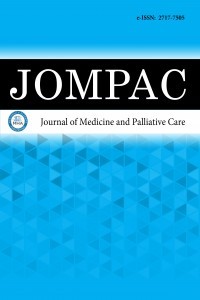Tip 2 diyabetes mellitus hastalarında elektrokardiyografik aritmojenite indekslerinin değerlendirilmesi
Aritmi, diyabetes mellitus, QTc, T peak-T end intervali, Tp-e/QTc
Evaluation of electrocardiographic arrhythmogenicity markers in patients with type 2 diabetes mellitus
Arrhythmia Diabetes mellitus, HbA1c, QTc, T peak-T end interval, Tp-e/QTc,
___
- Stumvoll M, Goldstein BJ, van Haeften TW. Type 2 diabetes: principles of pathogenesis and therapy. Lancet. 2005;365(9467):1333-1346.
- Rivellese AA, Riccardi G, Vaccaro O. Cardiovascular risk in women with diabetes. Nutr Metab Cardiovasc Dis. 2010;20(6):474-480.
- Boulton AJ, Vinik AI, Arezzo JC, et al. Diabetic neuropathies: a statement by the American Diabetes Association. Diabetes Care. 2005;28(4):956-962.
- Verrier RL, Antzelevitch C. Autonomic aspects of arrhythmogenesis: the enduring and the new. Curr Opin Cardiol. 2004;19(1):2-11.
- Kluppelholz B, Thorand B, Koenig W, et al. Association of subclinical inflammation with deterioration of glycaemia before the diagnosis of type 2 diabetes: the KORA S4/F4 study. Diabetologia. 2015;58(10):2269-2277.
- Aburisheh K, AlKheraiji MF, Alwalan SI, et al. Prevalence of QT prolongation and its risk factors in patients with type 2 diabetes. BMC Endocr Disord. 2023;23(1):50.
- Cox AJ, Azeem A, Yeboah J, et al. Heart rate-corrected QT interval is an independent predictor of all-cause and cardiovascular mortality in individuals with type 2 diabetes: the Diabetes Heart Study. Diabetes Care. 2014;37(5):1454-1461.
- Naas AA, Davidson NC, Thompson C, et al. QT and QTc dispersion are accurate predictors of cardiac death in newly diagnosed non-insulin dependent diabetes: cohort study. BMJ. 1998;316(7133):745-746.
- Tokatli A, Kiliçaslan F, Alis M, Yiginer O, Uzun M. Prolonged Tp-e Interval, Tp-e/QT Ratio and Tp-e/QTc Ratio in Patients with Type 2 Diabetes Mellitus. Endocrinol Metab (Seoul). 2016;31(1):105-112.
- Kuzu F. The effect of type 2 diabetes on electrocardiographic markers of significant cardiac events. Pak J Med Sci. 2018;34(3):626-632.
- Yamaguchi M, Shimizu M, Ino H, et al. T wave peak-to-end interval and QT dispersion in acquired long QT syndrome: a new index for arrhythmogenicity. Clin Sci. 2003;105(6):671-676.
- Dahlberg P, Diamant UB, Gilljam T, Rydberg A, Bergfeldt L. QT correction using Bazett’s formula remains preferable in long QT syndrome type 1 and 2. Ann Noninvasive Electrocardiol. 2021;26(1):e12804.
- Svane J, Pedersen-Bjergaard U, Tfelt-Hansen J. Diabetes and the Risk of Sudden Cardiac Death. Curr Cardiol Rep. 2020;22(10):112.
- Ninkovic VM, Ninkovic SM, Miloradovic V, et al. Prevalence and risk factors for prolonged QT interval and QT dispersion in patients with type 2 diabetes. Acta Diabetol. 2016;53(5):737-744.
- Stern K, Cho YH, Benitez-Aguirre P, et al. QT interval, corrected for heart rate, is associated with HbA1c concentration and autonomic function in diabetes. Diabet Med. 2016;33(10):1415-1421.
- Ninkovic VM, Ninkovic SM, Miloradovic V, et al. Prevalence and risk factors for prolonged QT interval and QT dispersion in patients with type 2 diabetes. Acta Diabetol. 2016;53(5):737-744. doi:10.1007/s00592-016-0864-y
- Agarwal G, Singh SK. Arrhythmias in type 2 diabetes mellitus. Indian J Endocrinol Metab. 2017;21(5):715-718.
- Castro-Torres Y, Carmona-Puerta R, Katholi RE. Ventricular repolarization markers for predicting malignant arrhythmias in clinical practice. World J Clin Cases. 2015;16:3(8):705-720.
- Ardahanlı İ, Celik M. Comparison of Tp-e interval, QTc interval and Tp-e/QTc ratios between non-diabetic and prediabetic population. Ann Med Res. 2020; 27(12):3117-3122.
- Fox CS, Sullivan L, D’Agostino RB Sr, Wilson PW; Framingham Heart Study. The significant effect of diabetes duration on coronary heart disease mortality: the Framingham Heart Study. Diabetes Care. 2004;27(3):704-708.
- Kishi S, Gidding SS, Reis JP, et al. Association of insulin resistance and glycemic metabolic abnormalities with LV structure and function in middle age: the CARDIA Study. JACC Cardiovasc Imaging. 2017;10(2):105-114.
- Haffner SM, Mitchell BD, Stern MP, Hazuda HP. Macrovascular complications in Mexican Americans with type II diabetes. Diabetes Care. 1991;14(7):665-671.
- Waheed S, Dawn B, Gupta K. Association of corrected QT interval with body mass index, and the impact of this association on mortality: results from the third national health and nutrition examination survey. Obes Res Clin Pract. 2017;11(4):426-434.
- Bağcı A, Aksoy F. The frontal plane QRS-T angle may affect our perspective on prehypertension: a prospective study. Clin Exp Hypertens. 2021;43(5):402-407.
- Csige I, Ujvárosy D, Szabó Z, et al. The impact of obesity on the cardiovascular system. J Diabetes Res. 2018;2018:3407306.
- Lambert EA, Straznicky NE, Dixon JB, Lambert GW. Should the sympathetic nervous system be a target to improve cardiometabolic risk in obesity? Am J Physiol Heart Circulatory Physiol. 2015;309(2):H244-H58.
- Başlangıç: 2020
- Yayıncı: MediHealth Academy Yayıncılık
Mezun ve stajyer diş hekimlerinin endodontide antibiyotik kullanım bilgi seviyeleri
Celalettin TOPBAŞ, Serap KESKİN TUNÇ, Hüseyin GÜDÜCÜOĞLU
Suisid düşüncelerinde sosyal medya kullanımı ve kişilerarası faktörlerin önemi
Serdar ŞENOL, Mustafa KUŞAK, Ahmet Can SARI, Mehmet Emin KARA
Türkiye'de emetrop çocuklarda miyopi gelişimi ve progresyonu
Ajar KOÇAK, Onur YILDIRIM, Ayhan COŞGUN, Mustafa Hamidullah TÜRKKANI
Muhammed Bahaddin DURAK, Cem ŞİMŞEK, Yavuz ÇAĞIR, İlhami YÜKSEL
Bipolar bozukluk bilgilendirmesinde kaynak olarak YouTube videolarının incelenmesi
Acil servise başvuran hastane çalışanlarının iş kazası bildirimlerinin analizi
Akromegalik hastaların kolonoskopik değerlendirmesi: tek merkez deneyimi
Yasemin EMÜR GÜNAY, Serdar DURAK, Arif Mansur COŞAR, Murat ERKUT, Sami FİDAN
